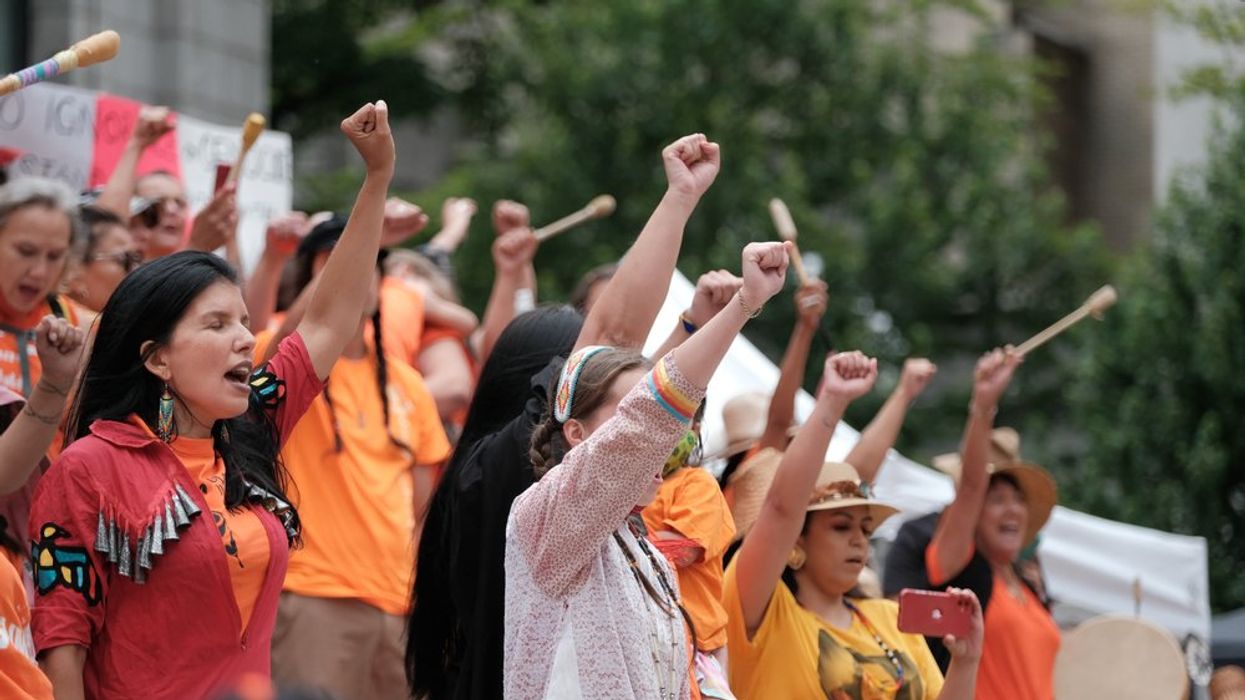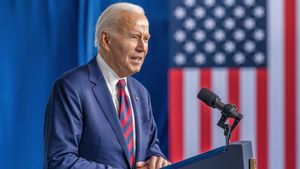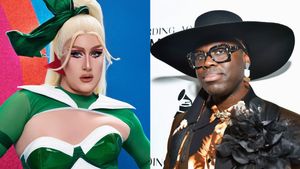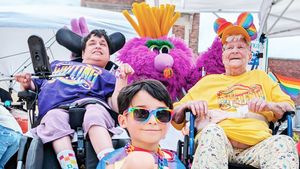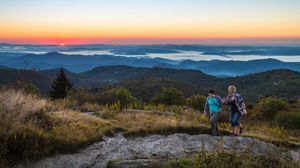Originally published by The 19th.Written by Chabeli Carrazana, Economy Reporter. At The 19th, we’re committed to publishing journalism that you can trust throughout the critical moments that shape our democracy and our lives. Show your support during our Fall Member Drive, and your donation will be matched. Double your gift today.
For Native American women, the gender pay gap reflects the systems that have oppressed them for centuries. The colonization that stripped them of power, the violence now plaguing them and the economic institutions that have left them behind — those factors have helped form a gap in income and wages that is among the widest of any group of women.
November 30 marked Native American Women’s Equal Pay Day, spotlighting that those working full- or part-time are still earning only 55 cents for every $1 paid to non-Latino White men. Only Latinas have a wider gap.
But 55 cents is, in many ways, an incomplete figure.
There is much that is unknown about the nuances of the pay gap for Native American women. For years, the United States has failed to invest in data collection on Indigenous communities, making it difficult to reliably track wage gaps among the 574 federally recognized tribes. What is known about a couple of the largest tribes is also extremely limited. The data is older and it relies on very small sample sizes that open significant room for error. And with differing locations, sizes and makeups, it’s next to impossible to compare the tribes with each other.
Still, the little data available offers some clues as to what may be driving the gap for different groups, revealing points of weakness in existing systems — and opportunities.
Like for most women, caregiving responsibilities limit the economic mobility of Native American women, who traditionally have cared for multiple generations often at once. That has an impact on entire communities. Sixty-four percent of Native mothers are breadwinners in their families. About a quarter of Native households are headed by women, with 30 percent of them living under the poverty level, according to census data compiled by the National Partnership for Women & Families.
“The time when you are more likely to have your most earning potential is also when you have the greatest demand of supporting your family structure,” said Lauren Grattan, co-founder and chief community officer of Mission Driven Finance, who works directly with Tribal Nations and Indigenous entrepreneurs. “That is particularly prevalent for Native American women.”
At the same time, more than 4 out of 5 Indigenous women experience violence in their lifetimes. They are two to three times more likely than other women to experience violence, stalking or sexual assault. That epidemic is “one of the major underpinnings that keeps Indigenous women from having that economic liberation,” said Vanessa Roanhorse, the CEO of Roanhorse Consulting, an Indigenous woman-led think tank, and co-founder of Native Women Lead, which supports Native women’s economic mobility.
Stacked on top are factors that are more specific to the makeup or location of tribes. Some of the tribes with the largest gaps include Navajo, Apache, Blackfoot, Pueblo and Sioux, while a couple of the Alaskan tribes have narrower gaps.
The Navajo Nation is the largest tribe by population and size, encompassing a land mass across New Mexico, Utah and Arizona. But Diné, or Navajo, women earn just 51 cents compared to the $1 for non-Latino White men.
Some of that gap has been manufactured by colonization. Historically, women in the Navajo Nation held significant power in their families and in their governments. Navajo are matrilineal, introducing themselves first through their mother’s clan. But colonialism forced assimilation onto Native American people, altering women’s place in Navajo society from largely equal to one where women were more dependent on men both politically and economically.
Children were forced to go to boarding school, stripping their mothers of their roles as educators in the family. Mines on Navajo lands in the early 1900s created new jobs largely for men. And then in the 1930s, a program by the U.S. government to kill thousands of livestock on Navajo lands, especially sheep, eliminated jobs and financial stability for the many Navajo women who owned and managed the sheep herds. Over time, their power continued to dwindle. That legacy has a lasting impact.
“We say that we are matrilineal or matriarchal — we have this respect for women — but in reality that is not what is seen,” said Navajo Nation Council Delegate Eugenia Charles-Newton. “I think a lot of it is the belief that women should not be leaders.”
The Navajo Council currently has more women on it than ever before, but the Nation has still never had a woman president. Charles-Newton said she’s been approached dozens of times by qualified women applying for positions in the tribal government who continue to get passed over.
One of the main issues affecting Native American women in general, she said, is that there are few jobs — and in particular specialized ones — on the reservation. Charles-Newton has a law degree and has worked as a law librarian and prosecutor, but she had to take a $60,000 pay cut when she returned to the Navajo Nation from Wyoming to care for her mother.
The concentration of women in lower-paying jobs, such as hospitality and retail, is the main driver of the pay gap, which captures the average wage for all Native American women together and compares that with the median wage of all non-Latino White men.
That leads to an exodus of young people. Keeping members on the reservation has long been a challenge, said Allie Redhorse Young, the director of Protect the Sacred, a nonprofit she founded during the pandemic in the Navajo Nation to protect Native elders, language and culture. Many students, she said, will go off to college and won’t return home because they can’t get the kind of jobs they’d like to with their degrees.
“Our leaders are trying to figure out: ‘Why can't those jobs exist at home?’” Redhorse Young said.
Pueblo people, who have one of the widest tribal gaps at 53 cents, also experience challenges with limited job opportunities and sexism. Gina Kallestewa, the assistant executive director at the Zuni Housing Authority, said religious beliefs around men as leaders have affected women in her community in rural New Mexico, who face pay discrepancies and unfair treatment.
“Culturally in Zuni, the final say-so is for the men,” she said. “That seems to be our struggle right now.”
Entrepreneurship, which has been viewed as the path to unlocking higher earning potential for Native American women, could be the answer, but many Pueblo communities in rural pockets of the country can’t pursue it due to limited Internet and broadband access.
“How can you run an Internet-based business or even have a marketing presence or be responsive to inquiries from clients and customers when those differences in access and infrastructure also play a role?” said Grattan of Mission Driven Finance.
Thanks to pandemic funding, Zuni Pueblo got fiber optic lines installed across the community. Kallestewa just got high-speed Internet installed last month.
In Navajo Nation, Roanhorse, who is a Diné citizen, said many of those hurdles to business ownership are also bureaucratic. The application for business registration alone requires applicants to prove they’re Navajo citizens and they must work with a Regional Business Development Office, but there are only five of those offices across the entire Nation, which is the size of West Virginia. Old infrastructure and limited staffing lead to long waitlists and delays. A process that took Roanhorse three hours to complete in New Mexico took her about three months in the Navajo Nation.
Native entrepreneurs also have to contend with unique challenges, like what kind of collateral they even have to stand up a business. Real estate is the most common asset business owners can put up as collateral to help obtain a loan. But Native people don’t own the land they live on — the land is leased from the tribal government, which leases it from the U.S. government.
Roanhorse is focused on ensuring women have more opportunities in that “middle gap of capital” so that entrepreneurship is a viable option.
“Then we can actually support them to have the agency to do whatever the hell they want to do with that money because we know, fundamentally, they will hire locally. They will make sure their kids are fed. They will make sure elders are cared for. And they will continue to be the culture bearers of our communities,” Roanhorse said.
Tribes that have had success with smaller wage gaps have done so in part through entrepreneurship.
Since the 1970s, Alaskan tribes have run regional corporations composed of Alaska Native shareholders that work to manage the lands they’re on and have been a source of income and economic mobility. They’ve also been able to access Small Business Administration loans set aside for minority-owned businesses.
Some of that impact can be seen reflected in the pay gap numbers. Iñupiat, Tlingit and Haida women earn 67 cents compared to $1 earned by non-Latino White men. Alaska Athabascan women earn 68 cents, according to data from 2017 to 2021. The tribal gaps are comparable to each other, but not to the overall wage gap figure because they are calculated differently.
“The villages have figured out how to utilize a Western structure like a corporation to create opportunities of collective decision making and tax dollars, and then also be a recipient of resources at a size that most tribes can't get because, again, it's all about, ‘What do your books look like? How much money do you have?’” Roanhorse said.
Grattan said some of the Alaskan tribes have been able to organize around sustainable tourism and cultural tourism that has allowed them to improve opportunities for women.
“Because of more displacement in other parts of the continent, you don't have that same opportunity, and Alaska is extraordinarily beautiful. So it's definitely an opportunity that allows for the communities there to be able to be expansive in the way that they're thinking about business development, and that being inclusive of women,” Grattan said.
And other tribes have focused on improved education, mentorship and apprenticeship opportunities for Native American students that are also driving smaller gaps.
Angelique Albert, the CEO of Native Forward Scholars Fund, the top funder of direct scholarship dollars to Native American students, said the fund is working with tribes to identify what jobs are needed, help students obtain scholarships in those fields and then encourage them to pursue careers back home. Those that do get loan forgiveness.
About 70 percent of the fund’s scholarships go to Native American women, Albert said. Secretary of the Interior Deb Haaland is an alumnus.
Albert, who is a member of the Confederated Salish and Kootenai tribes, said her tribe has placed a lot of focus on ensuring women are in positions of power. The Salish and Kootenai College is one of the top tribal colleges, where Albert got her undergraduate degree. Puget Sound Salish women have one of the narrowest gaps, earning 63 cents for every $1 earned by non-Latino White men.
Education for her, she said, is about giving back to her tribe. And efforts that focus on educating Native people and encouraging them to carry those teachings back to their communities could be important in closing the gap.
“For me, I define wealth differently, and most of us do. It's not what's in my bank account,” Albert said. “It's what my bank account has done to support my family, my extended family, my Tribal community. What have I done to give back?”
Telling Queer Indigenous Stories Through Art

Video Source: Advocate Channel
